Tuberculosis in Children: Urban Health Challenges in Camden Borough
VerifiedAdded on 2020/12/18
|13
|4639
|308
Report
AI Summary
This report provides a comprehensive analysis of tuberculosis (TB) in children residing in the Camden Borough. It begins with an introduction to TB, including its causative agent, Mycobacterium tuberculosis, and the distinction between latent and active forms of the disease. The report highlights the rationale for considering TB as an urban health issue, emphasizing factors such as poverty, overcrowding, and poor ventilation. It delves into the urban context and determinants influencing TB, focusing on the vulnerability of children and the impact of factors such as malnutrition, HIV, and diabetes. The report explores the consequences of TB on individuals, the general population, and healthcare services, and suggests strategies and interventions for addressing this urban health problem. It concludes with recommendations and references, providing a thorough overview of the challenges and potential solutions related to childhood TB in Camden Borough.
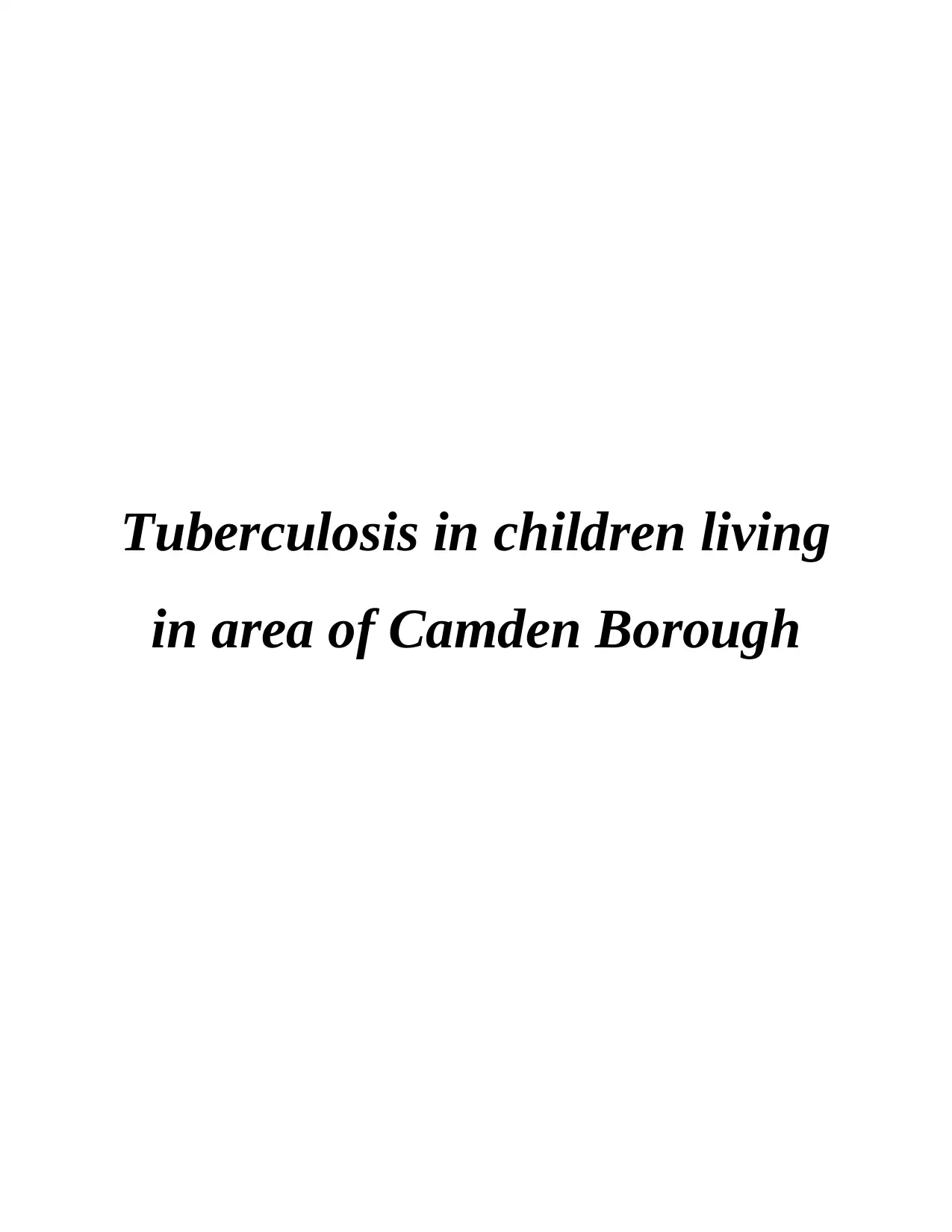
Tuberculosis in children living
in area of Camden Borough
in area of Camden Borough
Paraphrase This Document
Need a fresh take? Get an instant paraphrase of this document with our AI Paraphraser
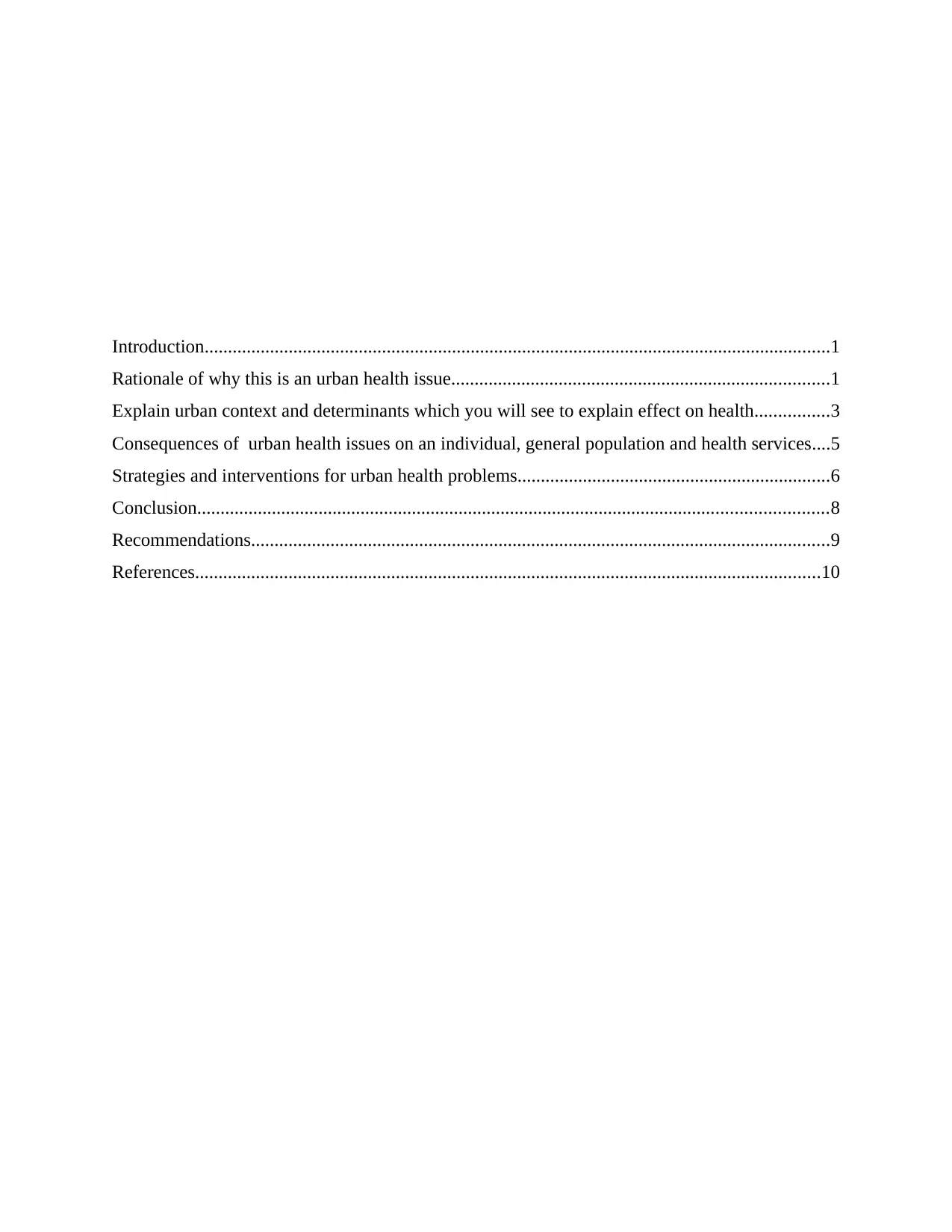
Introduction......................................................................................................................................1
Rationale of why this is an urban health issue.................................................................................1
Explain urban context and determinants which you will see to explain effect on health................3
Consequences of urban health issues on an individual, general population and health services....5
Strategies and interventions for urban health problems...................................................................6
Conclusion.......................................................................................................................................8
Recommendations............................................................................................................................9
References......................................................................................................................................10
Rationale of why this is an urban health issue.................................................................................1
Explain urban context and determinants which you will see to explain effect on health................3
Consequences of urban health issues on an individual, general population and health services....5
Strategies and interventions for urban health problems...................................................................6
Conclusion.......................................................................................................................................8
Recommendations............................................................................................................................9
References......................................................................................................................................10
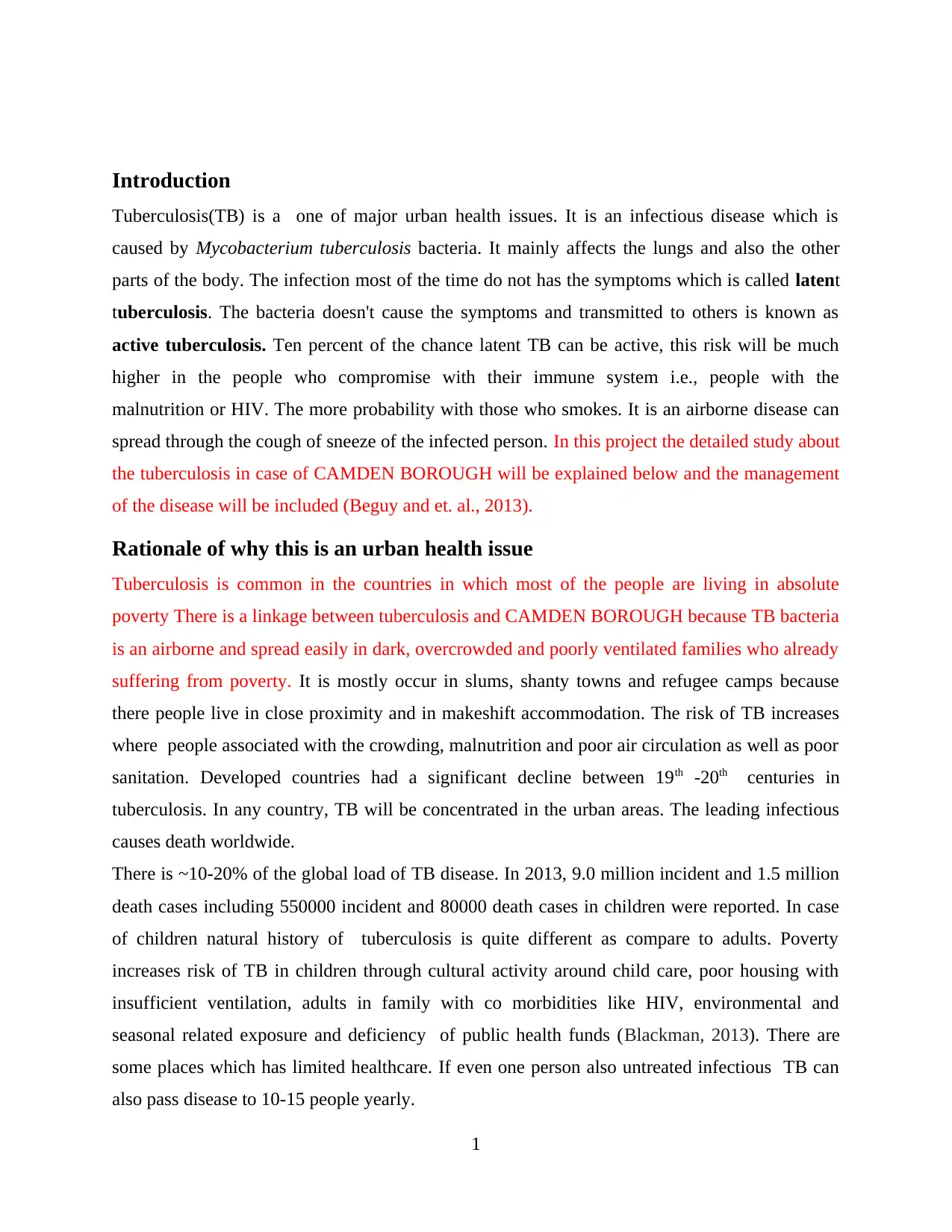
Introduction
Tuberculosis(TB) is a one of major urban health issues. It is an infectious disease which is
caused by Mycobacterium tuberculosis bacteria. It mainly affects the lungs and also the other
parts of the body. The infection most of the time do not has the symptoms which is called latent
tuberculosis. The bacteria doesn't cause the symptoms and transmitted to others is known as
active tuberculosis. Ten percent of the chance latent TB can be active, this risk will be much
higher in the people who compromise with their immune system i.e., people with the
malnutrition or HIV. The more probability with those who smokes. It is an airborne disease can
spread through the cough of sneeze of the infected person. In this project the detailed study about
the tuberculosis in case of CAMDEN BOROUGH will be explained below and the management
of the disease will be included (Beguy and et. al., 2013).
Rationale of why this is an urban health issue
Tuberculosis is common in the countries in which most of the people are living in absolute
poverty There is a linkage between tuberculosis and CAMDEN BOROUGH because TB bacteria
is an airborne and spread easily in dark, overcrowded and poorly ventilated families who already
suffering from poverty. It is mostly occur in slums, shanty towns and refugee camps because
there people live in close proximity and in makeshift accommodation. The risk of TB increases
where people associated with the crowding, malnutrition and poor air circulation as well as poor
sanitation. Developed countries had a significant decline between 19th -20th centuries in
tuberculosis. In any country, TB will be concentrated in the urban areas. The leading infectious
causes death worldwide.
There is ~10-20% of the global load of TB disease. In 2013, 9.0 million incident and 1.5 million
death cases including 550000 incident and 80000 death cases in children were reported. In case
of children natural history of tuberculosis is quite different as compare to adults. Poverty
increases risk of TB in children through cultural activity around child care, poor housing with
insufficient ventilation, adults in family with co morbidities like HIV, environmental and
seasonal related exposure and deficiency of public health funds (Blackman, 2013). There are
some places which has limited healthcare. If even one person also untreated infectious TB can
also pass disease to 10-15 people yearly.
1
Tuberculosis(TB) is a one of major urban health issues. It is an infectious disease which is
caused by Mycobacterium tuberculosis bacteria. It mainly affects the lungs and also the other
parts of the body. The infection most of the time do not has the symptoms which is called latent
tuberculosis. The bacteria doesn't cause the symptoms and transmitted to others is known as
active tuberculosis. Ten percent of the chance latent TB can be active, this risk will be much
higher in the people who compromise with their immune system i.e., people with the
malnutrition or HIV. The more probability with those who smokes. It is an airborne disease can
spread through the cough of sneeze of the infected person. In this project the detailed study about
the tuberculosis in case of CAMDEN BOROUGH will be explained below and the management
of the disease will be included (Beguy and et. al., 2013).
Rationale of why this is an urban health issue
Tuberculosis is common in the countries in which most of the people are living in absolute
poverty There is a linkage between tuberculosis and CAMDEN BOROUGH because TB bacteria
is an airborne and spread easily in dark, overcrowded and poorly ventilated families who already
suffering from poverty. It is mostly occur in slums, shanty towns and refugee camps because
there people live in close proximity and in makeshift accommodation. The risk of TB increases
where people associated with the crowding, malnutrition and poor air circulation as well as poor
sanitation. Developed countries had a significant decline between 19th -20th centuries in
tuberculosis. In any country, TB will be concentrated in the urban areas. The leading infectious
causes death worldwide.
There is ~10-20% of the global load of TB disease. In 2013, 9.0 million incident and 1.5 million
death cases including 550000 incident and 80000 death cases in children were reported. In case
of children natural history of tuberculosis is quite different as compare to adults. Poverty
increases risk of TB in children through cultural activity around child care, poor housing with
insufficient ventilation, adults in family with co morbidities like HIV, environmental and
seasonal related exposure and deficiency of public health funds (Blackman, 2013). There are
some places which has limited healthcare. If even one person also untreated infectious TB can
also pass disease to 10-15 people yearly.
1
⊘ This is a preview!⊘
Do you want full access?
Subscribe today to unlock all pages.

Trusted by 1+ million students worldwide
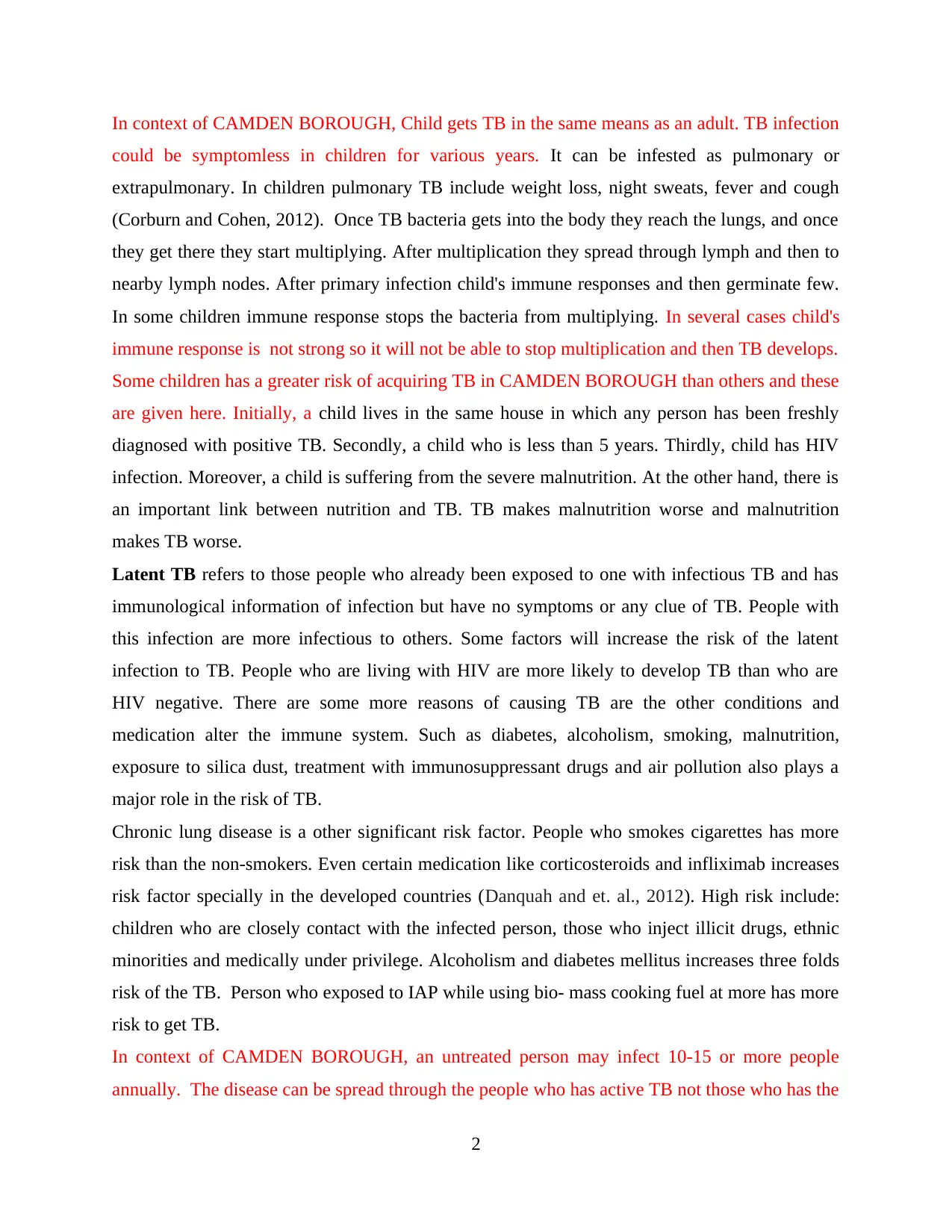
In context of CAMDEN BOROUGH, Child gets TB in the same means as an adult. TB infection
could be symptomless in children for various years. It can be infested as pulmonary or
extrapulmonary. In children pulmonary TB include weight loss, night sweats, fever and cough
(Corburn and Cohen, 2012). Once TB bacteria gets into the body they reach the lungs, and once
they get there they start multiplying. After multiplication they spread through lymph and then to
nearby lymph nodes. After primary infection child's immune responses and then germinate few.
In some children immune response stops the bacteria from multiplying. In several cases child's
immune response is not strong so it will not be able to stop multiplication and then TB develops.
Some children has a greater risk of acquiring TB in CAMDEN BOROUGH than others and these
are given here. Initially, a child lives in the same house in which any person has been freshly
diagnosed with positive TB. Secondly, a child who is less than 5 years. Thirdly, child has HIV
infection. Moreover, a child is suffering from the severe malnutrition. At the other hand, there is
an important link between nutrition and TB. TB makes malnutrition worse and malnutrition
makes TB worse.
Latent TB refers to those people who already been exposed to one with infectious TB and has
immunological information of infection but have no symptoms or any clue of TB. People with
this infection are more infectious to others. Some factors will increase the risk of the latent
infection to TB. People who are living with HIV are more likely to develop TB than who are
HIV negative. There are some more reasons of causing TB are the other conditions and
medication alter the immune system. Such as diabetes, alcoholism, smoking, malnutrition,
exposure to silica dust, treatment with immunosuppressant drugs and air pollution also plays a
major role in the risk of TB.
Chronic lung disease is a other significant risk factor. People who smokes cigarettes has more
risk than the non-smokers. Even certain medication like corticosteroids and infliximab increases
risk factor specially in the developed countries (Danquah and et. al., 2012). High risk include:
children who are closely contact with the infected person, those who inject illicit drugs, ethnic
minorities and medically under privilege. Alcoholism and diabetes mellitus increases three folds
risk of the TB. Person who exposed to IAP while using bio- mass cooking fuel at more has more
risk to get TB.
In context of CAMDEN BOROUGH, an untreated person may infect 10-15 or more people
annually. The disease can be spread through the people who has active TB not those who has the
2
could be symptomless in children for various years. It can be infested as pulmonary or
extrapulmonary. In children pulmonary TB include weight loss, night sweats, fever and cough
(Corburn and Cohen, 2012). Once TB bacteria gets into the body they reach the lungs, and once
they get there they start multiplying. After multiplication they spread through lymph and then to
nearby lymph nodes. After primary infection child's immune responses and then germinate few.
In some children immune response stops the bacteria from multiplying. In several cases child's
immune response is not strong so it will not be able to stop multiplication and then TB develops.
Some children has a greater risk of acquiring TB in CAMDEN BOROUGH than others and these
are given here. Initially, a child lives in the same house in which any person has been freshly
diagnosed with positive TB. Secondly, a child who is less than 5 years. Thirdly, child has HIV
infection. Moreover, a child is suffering from the severe malnutrition. At the other hand, there is
an important link between nutrition and TB. TB makes malnutrition worse and malnutrition
makes TB worse.
Latent TB refers to those people who already been exposed to one with infectious TB and has
immunological information of infection but have no symptoms or any clue of TB. People with
this infection are more infectious to others. Some factors will increase the risk of the latent
infection to TB. People who are living with HIV are more likely to develop TB than who are
HIV negative. There are some more reasons of causing TB are the other conditions and
medication alter the immune system. Such as diabetes, alcoholism, smoking, malnutrition,
exposure to silica dust, treatment with immunosuppressant drugs and air pollution also plays a
major role in the risk of TB.
Chronic lung disease is a other significant risk factor. People who smokes cigarettes has more
risk than the non-smokers. Even certain medication like corticosteroids and infliximab increases
risk factor specially in the developed countries (Danquah and et. al., 2012). High risk include:
children who are closely contact with the infected person, those who inject illicit drugs, ethnic
minorities and medically under privilege. Alcoholism and diabetes mellitus increases three folds
risk of the TB. Person who exposed to IAP while using bio- mass cooking fuel at more has more
risk to get TB.
In context of CAMDEN BOROUGH, an untreated person may infect 10-15 or more people
annually. The disease can be spread through the people who has active TB not those who has the
2
Paraphrase This Document
Need a fresh take? Get an instant paraphrase of this document with our AI Paraphraser
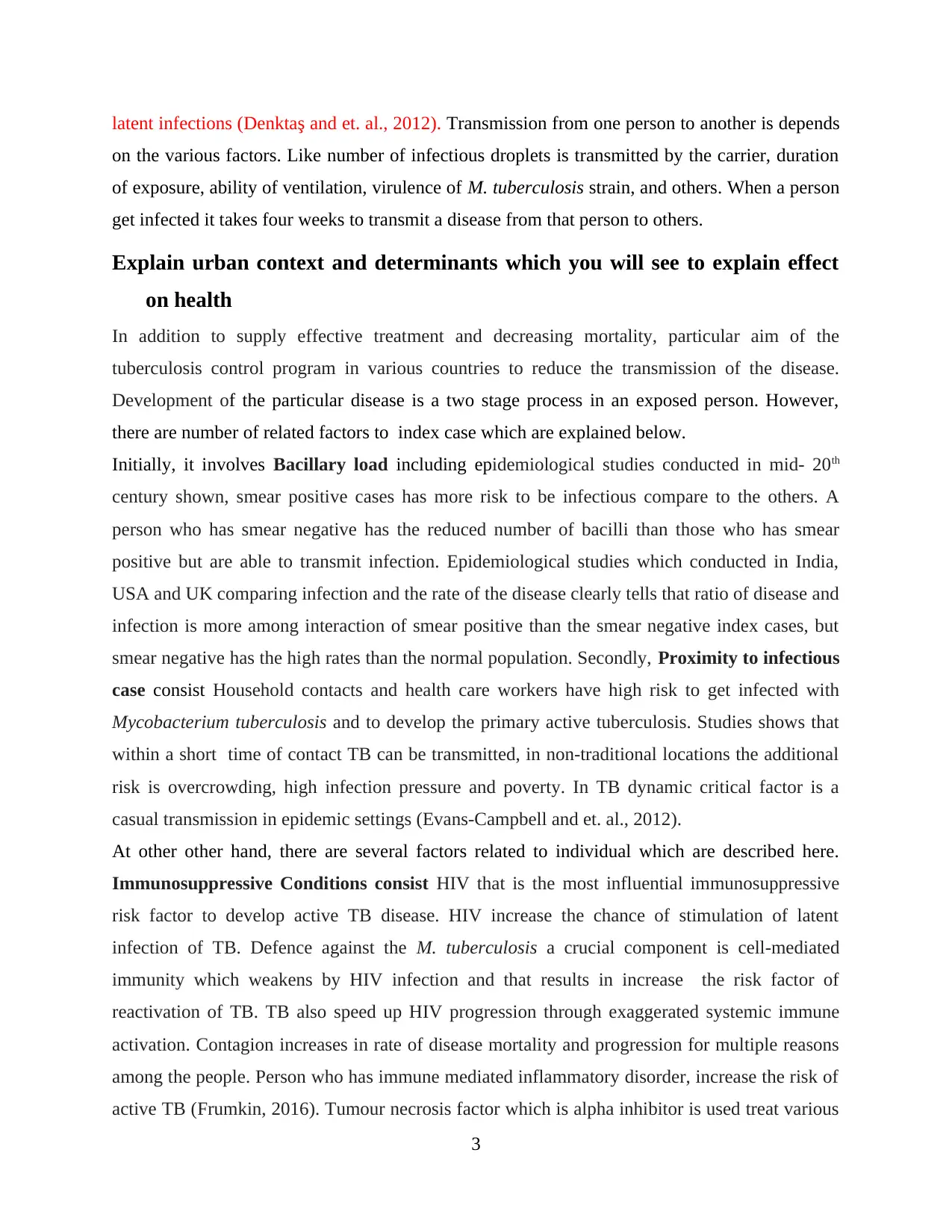
latent infections (Denktaş and et. al., 2012). Transmission from one person to another is depends
on the various factors. Like number of infectious droplets is transmitted by the carrier, duration
of exposure, ability of ventilation, virulence of M. tuberculosis strain, and others. When a person
get infected it takes four weeks to transmit a disease from that person to others.
Explain urban context and determinants which you will see to explain effect
on health
In addition to supply effective treatment and decreasing mortality, particular aim of the
tuberculosis control program in various countries to reduce the transmission of the disease.
Development of the particular disease is a two stage process in an exposed person. However,
there are number of related factors to index case which are explained below.
Initially, it involves Bacillary load including epidemiological studies conducted in mid- 20th
century shown, smear positive cases has more risk to be infectious compare to the others. A
person who has smear negative has the reduced number of bacilli than those who has smear
positive but are able to transmit infection. Epidemiological studies which conducted in India,
USA and UK comparing infection and the rate of the disease clearly tells that ratio of disease and
infection is more among interaction of smear positive than the smear negative index cases, but
smear negative has the high rates than the normal population. Secondly, Proximity to infectious
case consist Household contacts and health care workers have high risk to get infected with
Mycobacterium tuberculosis and to develop the primary active tuberculosis. Studies shows that
within a short time of contact TB can be transmitted, in non-traditional locations the additional
risk is overcrowding, high infection pressure and poverty. In TB dynamic critical factor is a
casual transmission in epidemic settings (Evans-Campbell and et. al., 2012).
At other other hand, there are several factors related to individual which are described here.
Immunosuppressive Conditions consist HIV that is the most influential immunosuppressive
risk factor to develop active TB disease. HIV increase the chance of stimulation of latent
infection of TB. Defence against the M. tuberculosis a crucial component is cell-mediated
immunity which weakens by HIV infection and that results in increase the risk factor of
reactivation of TB. TB also speed up HIV progression through exaggerated systemic immune
activation. Contagion increases in rate of disease mortality and progression for multiple reasons
among the people. Person who has immune mediated inflammatory disorder, increase the risk of
active TB (Frumkin, 2016). Tumour necrosis factor which is alpha inhibitor is used treat various
3
on the various factors. Like number of infectious droplets is transmitted by the carrier, duration
of exposure, ability of ventilation, virulence of M. tuberculosis strain, and others. When a person
get infected it takes four weeks to transmit a disease from that person to others.
Explain urban context and determinants which you will see to explain effect
on health
In addition to supply effective treatment and decreasing mortality, particular aim of the
tuberculosis control program in various countries to reduce the transmission of the disease.
Development of the particular disease is a two stage process in an exposed person. However,
there are number of related factors to index case which are explained below.
Initially, it involves Bacillary load including epidemiological studies conducted in mid- 20th
century shown, smear positive cases has more risk to be infectious compare to the others. A
person who has smear negative has the reduced number of bacilli than those who has smear
positive but are able to transmit infection. Epidemiological studies which conducted in India,
USA and UK comparing infection and the rate of the disease clearly tells that ratio of disease and
infection is more among interaction of smear positive than the smear negative index cases, but
smear negative has the high rates than the normal population. Secondly, Proximity to infectious
case consist Household contacts and health care workers have high risk to get infected with
Mycobacterium tuberculosis and to develop the primary active tuberculosis. Studies shows that
within a short time of contact TB can be transmitted, in non-traditional locations the additional
risk is overcrowding, high infection pressure and poverty. In TB dynamic critical factor is a
casual transmission in epidemic settings (Evans-Campbell and et. al., 2012).
At other other hand, there are several factors related to individual which are described here.
Immunosuppressive Conditions consist HIV that is the most influential immunosuppressive
risk factor to develop active TB disease. HIV increase the chance of stimulation of latent
infection of TB. Defence against the M. tuberculosis a crucial component is cell-mediated
immunity which weakens by HIV infection and that results in increase the risk factor of
reactivation of TB. TB also speed up HIV progression through exaggerated systemic immune
activation. Contagion increases in rate of disease mortality and progression for multiple reasons
among the people. Person who has immune mediated inflammatory disorder, increase the risk of
active TB (Frumkin, 2016). Tumour necrosis factor which is alpha inhibitor is used treat various
3
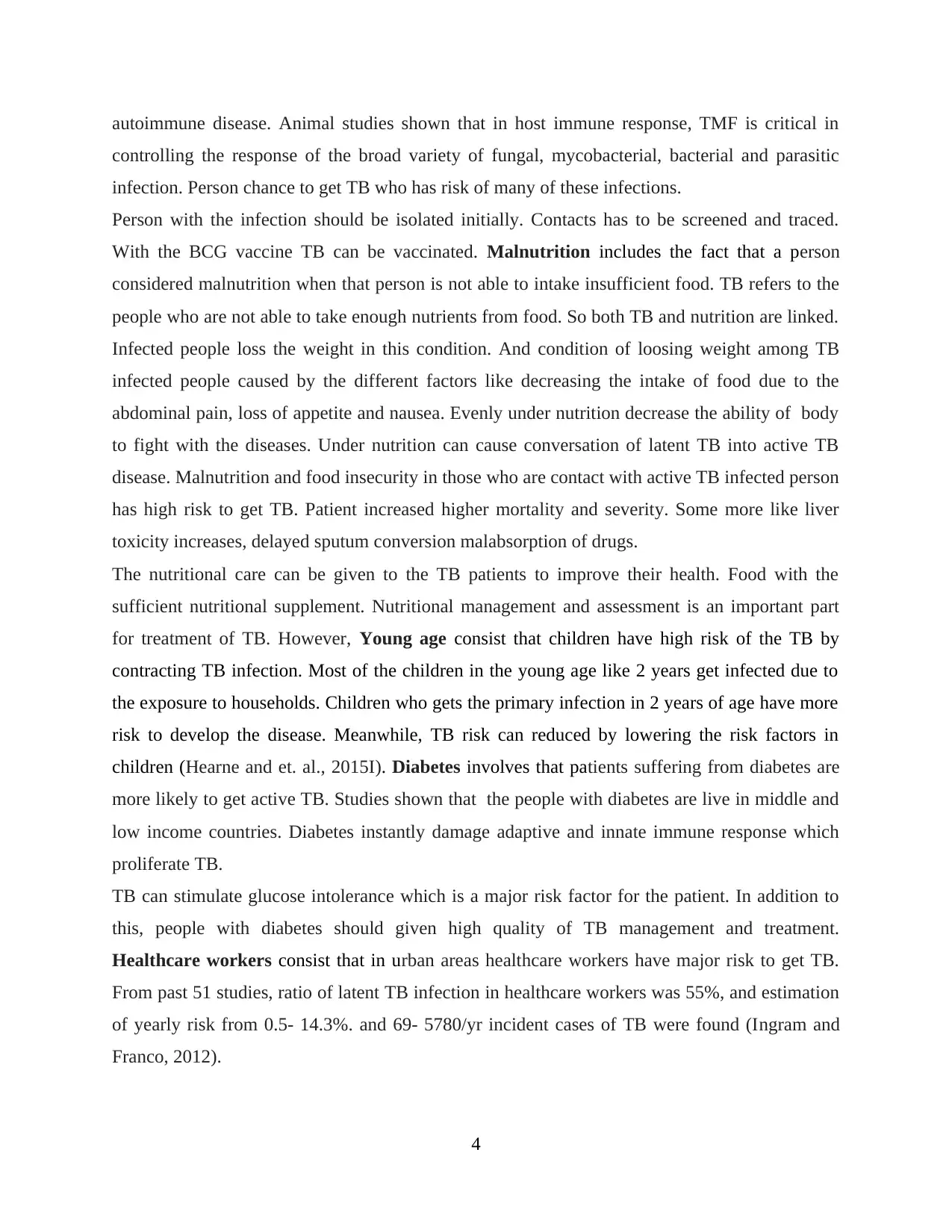
autoimmune disease. Animal studies shown that in host immune response, TMF is critical in
controlling the response of the broad variety of fungal, mycobacterial, bacterial and parasitic
infection. Person chance to get TB who has risk of many of these infections.
Person with the infection should be isolated initially. Contacts has to be screened and traced.
With the BCG vaccine TB can be vaccinated. Malnutrition includes the fact that a person
considered malnutrition when that person is not able to intake insufficient food. TB refers to the
people who are not able to take enough nutrients from food. So both TB and nutrition are linked.
Infected people loss the weight in this condition. And condition of loosing weight among TB
infected people caused by the different factors like decreasing the intake of food due to the
abdominal pain, loss of appetite and nausea. Evenly under nutrition decrease the ability of body
to fight with the diseases. Under nutrition can cause conversation of latent TB into active TB
disease. Malnutrition and food insecurity in those who are contact with active TB infected person
has high risk to get TB. Patient increased higher mortality and severity. Some more like liver
toxicity increases, delayed sputum conversion malabsorption of drugs.
The nutritional care can be given to the TB patients to improve their health. Food with the
sufficient nutritional supplement. Nutritional management and assessment is an important part
for treatment of TB. However, Young age consist that children have high risk of the TB by
contracting TB infection. Most of the children in the young age like 2 years get infected due to
the exposure to households. Children who gets the primary infection in 2 years of age have more
risk to develop the disease. Meanwhile, TB risk can reduced by lowering the risk factors in
children (Hearne and et. al., 2015I). Diabetes involves that patients suffering from diabetes are
more likely to get active TB. Studies shown that the people with diabetes are live in middle and
low income countries. Diabetes instantly damage adaptive and innate immune response which
proliferate TB.
TB can stimulate glucose intolerance which is a major risk factor for the patient. In addition to
this, people with diabetes should given high quality of TB management and treatment.
Healthcare workers consist that in urban areas healthcare workers have major risk to get TB.
From past 51 studies, ratio of latent TB infection in healthcare workers was 55%, and estimation
of yearly risk from 0.5- 14.3%. and 69- 5780/yr incident cases of TB were found (Ingram and
Franco, 2012).
4
controlling the response of the broad variety of fungal, mycobacterial, bacterial and parasitic
infection. Person chance to get TB who has risk of many of these infections.
Person with the infection should be isolated initially. Contacts has to be screened and traced.
With the BCG vaccine TB can be vaccinated. Malnutrition includes the fact that a person
considered malnutrition when that person is not able to intake insufficient food. TB refers to the
people who are not able to take enough nutrients from food. So both TB and nutrition are linked.
Infected people loss the weight in this condition. And condition of loosing weight among TB
infected people caused by the different factors like decreasing the intake of food due to the
abdominal pain, loss of appetite and nausea. Evenly under nutrition decrease the ability of body
to fight with the diseases. Under nutrition can cause conversation of latent TB into active TB
disease. Malnutrition and food insecurity in those who are contact with active TB infected person
has high risk to get TB. Patient increased higher mortality and severity. Some more like liver
toxicity increases, delayed sputum conversion malabsorption of drugs.
The nutritional care can be given to the TB patients to improve their health. Food with the
sufficient nutritional supplement. Nutritional management and assessment is an important part
for treatment of TB. However, Young age consist that children have high risk of the TB by
contracting TB infection. Most of the children in the young age like 2 years get infected due to
the exposure to households. Children who gets the primary infection in 2 years of age have more
risk to develop the disease. Meanwhile, TB risk can reduced by lowering the risk factors in
children (Hearne and et. al., 2015I). Diabetes involves that patients suffering from diabetes are
more likely to get active TB. Studies shown that the people with diabetes are live in middle and
low income countries. Diabetes instantly damage adaptive and innate immune response which
proliferate TB.
TB can stimulate glucose intolerance which is a major risk factor for the patient. In addition to
this, people with diabetes should given high quality of TB management and treatment.
Healthcare workers consist that in urban areas healthcare workers have major risk to get TB.
From past 51 studies, ratio of latent TB infection in healthcare workers was 55%, and estimation
of yearly risk from 0.5- 14.3%. and 69- 5780/yr incident cases of TB were found (Ingram and
Franco, 2012).
4
⊘ This is a preview!⊘
Do you want full access?
Subscribe today to unlock all pages.

Trusted by 1+ million students worldwide
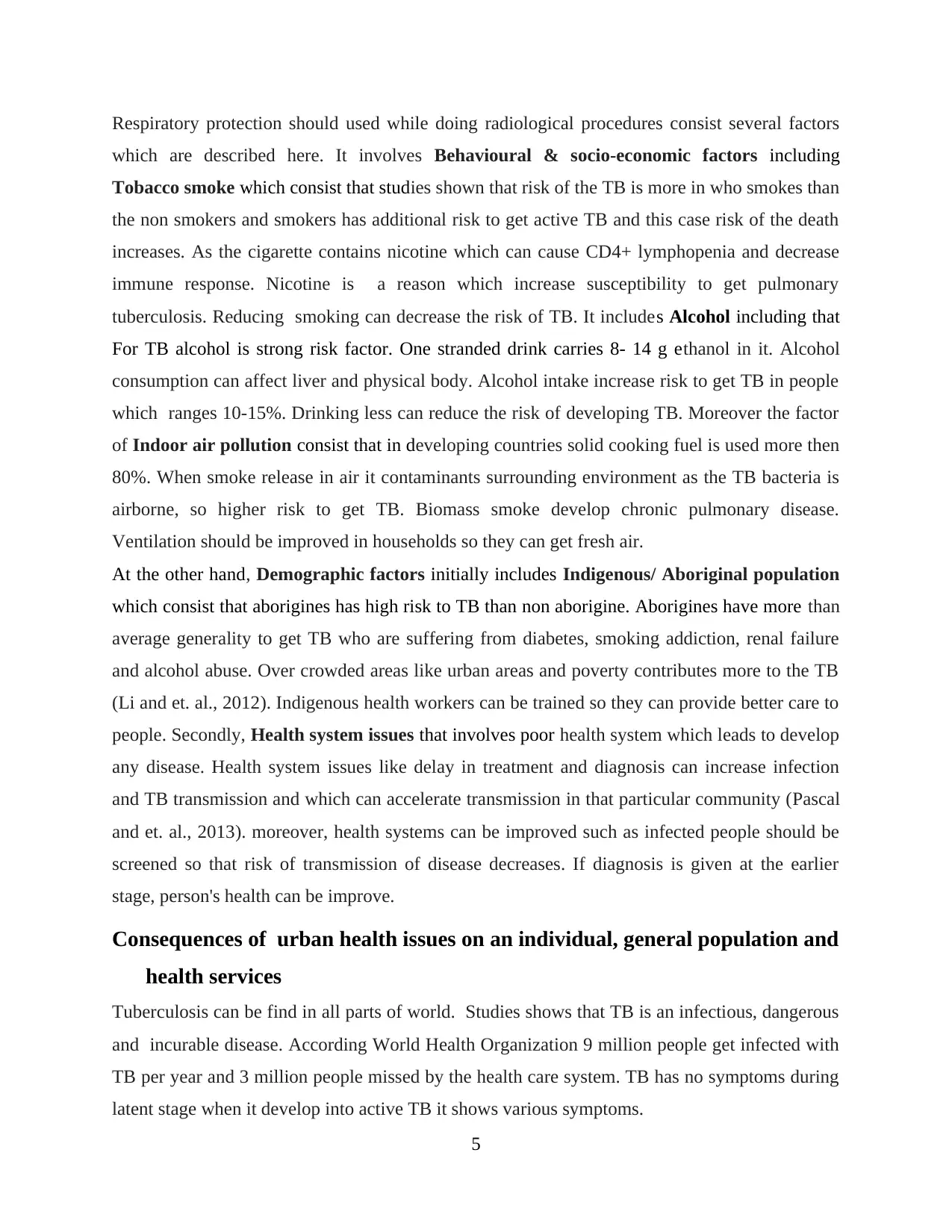
Respiratory protection should used while doing radiological procedures consist several factors
which are described here. It involves Behavioural & socio-economic factors including
Tobacco smoke which consist that studies shown that risk of the TB is more in who smokes than
the non smokers and smokers has additional risk to get active TB and this case risk of the death
increases. As the cigarette contains nicotine which can cause CD4+ lymphopenia and decrease
immune response. Nicotine is a reason which increase susceptibility to get pulmonary
tuberculosis. Reducing smoking can decrease the risk of TB. It includes Alcohol including that
For TB alcohol is strong risk factor. One stranded drink carries 8- 14 g ethanol in it. Alcohol
consumption can affect liver and physical body. Alcohol intake increase risk to get TB in people
which ranges 10-15%. Drinking less can reduce the risk of developing TB. Moreover the factor
of Indoor air pollution consist that in developing countries solid cooking fuel is used more then
80%. When smoke release in air it contaminants surrounding environment as the TB bacteria is
airborne, so higher risk to get TB. Biomass smoke develop chronic pulmonary disease.
Ventilation should be improved in households so they can get fresh air.
At the other hand, Demographic factors initially includes Indigenous/ Aboriginal population
which consist that aborigines has high risk to TB than non aborigine. Aborigines have more than
average generality to get TB who are suffering from diabetes, smoking addiction, renal failure
and alcohol abuse. Over crowded areas like urban areas and poverty contributes more to the TB
(Li and et. al., 2012). Indigenous health workers can be trained so they can provide better care to
people. Secondly, Health system issues that involves poor health system which leads to develop
any disease. Health system issues like delay in treatment and diagnosis can increase infection
and TB transmission and which can accelerate transmission in that particular community (Pascal
and et. al., 2013). moreover, health systems can be improved such as infected people should be
screened so that risk of transmission of disease decreases. If diagnosis is given at the earlier
stage, person's health can be improve.
Consequences of urban health issues on an individual, general population and
health services
Tuberculosis can be find in all parts of world. Studies shows that TB is an infectious, dangerous
and incurable disease. According World Health Organization 9 million people get infected with
TB per year and 3 million people missed by the health care system. TB has no symptoms during
latent stage when it develop into active TB it shows various symptoms.
5
which are described here. It involves Behavioural & socio-economic factors including
Tobacco smoke which consist that studies shown that risk of the TB is more in who smokes than
the non smokers and smokers has additional risk to get active TB and this case risk of the death
increases. As the cigarette contains nicotine which can cause CD4+ lymphopenia and decrease
immune response. Nicotine is a reason which increase susceptibility to get pulmonary
tuberculosis. Reducing smoking can decrease the risk of TB. It includes Alcohol including that
For TB alcohol is strong risk factor. One stranded drink carries 8- 14 g ethanol in it. Alcohol
consumption can affect liver and physical body. Alcohol intake increase risk to get TB in people
which ranges 10-15%. Drinking less can reduce the risk of developing TB. Moreover the factor
of Indoor air pollution consist that in developing countries solid cooking fuel is used more then
80%. When smoke release in air it contaminants surrounding environment as the TB bacteria is
airborne, so higher risk to get TB. Biomass smoke develop chronic pulmonary disease.
Ventilation should be improved in households so they can get fresh air.
At the other hand, Demographic factors initially includes Indigenous/ Aboriginal population
which consist that aborigines has high risk to TB than non aborigine. Aborigines have more than
average generality to get TB who are suffering from diabetes, smoking addiction, renal failure
and alcohol abuse. Over crowded areas like urban areas and poverty contributes more to the TB
(Li and et. al., 2012). Indigenous health workers can be trained so they can provide better care to
people. Secondly, Health system issues that involves poor health system which leads to develop
any disease. Health system issues like delay in treatment and diagnosis can increase infection
and TB transmission and which can accelerate transmission in that particular community (Pascal
and et. al., 2013). moreover, health systems can be improved such as infected people should be
screened so that risk of transmission of disease decreases. If diagnosis is given at the earlier
stage, person's health can be improve.
Consequences of urban health issues on an individual, general population and
health services
Tuberculosis can be find in all parts of world. Studies shows that TB is an infectious, dangerous
and incurable disease. According World Health Organization 9 million people get infected with
TB per year and 3 million people missed by the health care system. TB has no symptoms during
latent stage when it develop into active TB it shows various symptoms.
5
Paraphrase This Document
Need a fresh take? Get an instant paraphrase of this document with our AI Paraphraser
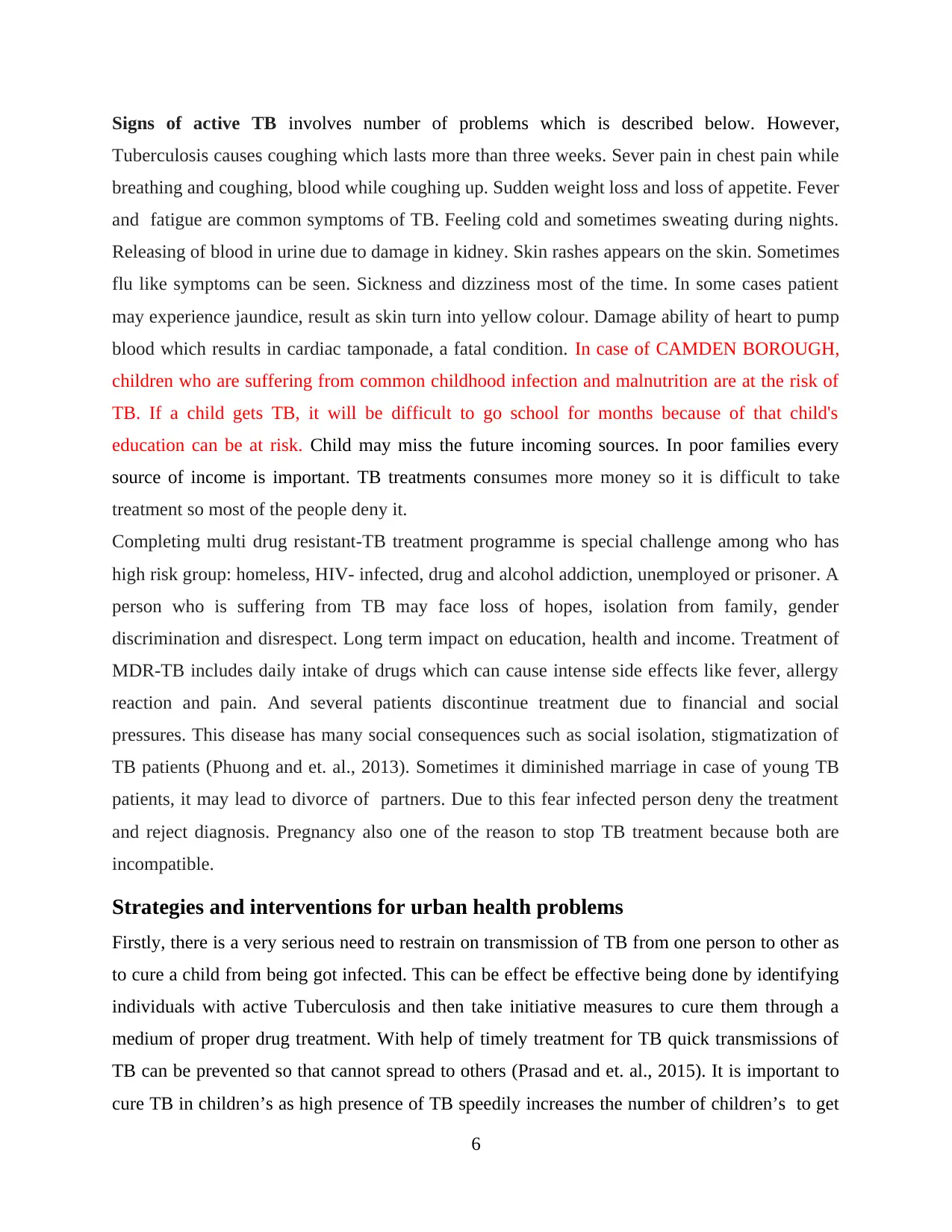
Signs of active TB involves number of problems which is described below. However,
Tuberculosis causes coughing which lasts more than three weeks. Sever pain in chest pain while
breathing and coughing, blood while coughing up. Sudden weight loss and loss of appetite. Fever
and fatigue are common symptoms of TB. Feeling cold and sometimes sweating during nights.
Releasing of blood in urine due to damage in kidney. Skin rashes appears on the skin. Sometimes
flu like symptoms can be seen. Sickness and dizziness most of the time. In some cases patient
may experience jaundice, result as skin turn into yellow colour. Damage ability of heart to pump
blood which results in cardiac tamponade, a fatal condition. In case of CAMDEN BOROUGH,
children who are suffering from common childhood infection and malnutrition are at the risk of
TB. If a child gets TB, it will be difficult to go school for months because of that child's
education can be at risk. Child may miss the future incoming sources. In poor families every
source of income is important. TB treatments consumes more money so it is difficult to take
treatment so most of the people deny it.
Completing multi drug resistant-TB treatment programme is special challenge among who has
high risk group: homeless, HIV- infected, drug and alcohol addiction, unemployed or prisoner. A
person who is suffering from TB may face loss of hopes, isolation from family, gender
discrimination and disrespect. Long term impact on education, health and income. Treatment of
MDR-TB includes daily intake of drugs which can cause intense side effects like fever, allergy
reaction and pain. And several patients discontinue treatment due to financial and social
pressures. This disease has many social consequences such as social isolation, stigmatization of
TB patients (Phuong and et. al., 2013). Sometimes it diminished marriage in case of young TB
patients, it may lead to divorce of partners. Due to this fear infected person deny the treatment
and reject diagnosis. Pregnancy also one of the reason to stop TB treatment because both are
incompatible.
Strategies and interventions for urban health problems
Firstly, there is a very serious need to restrain on transmission of TB from one person to other as
to cure a child from being got infected. This can be effect be effective being done by identifying
individuals with active Tuberculosis and then take initiative measures to cure them through a
medium of proper drug treatment. With help of timely treatment for TB quick transmissions of
TB can be prevented so that cannot spread to others (Prasad and et. al., 2015). It is important to
cure TB in children’s as high presence of TB speedily increases the number of children’s to get
6
Tuberculosis causes coughing which lasts more than three weeks. Sever pain in chest pain while
breathing and coughing, blood while coughing up. Sudden weight loss and loss of appetite. Fever
and fatigue are common symptoms of TB. Feeling cold and sometimes sweating during nights.
Releasing of blood in urine due to damage in kidney. Skin rashes appears on the skin. Sometimes
flu like symptoms can be seen. Sickness and dizziness most of the time. In some cases patient
may experience jaundice, result as skin turn into yellow colour. Damage ability of heart to pump
blood which results in cardiac tamponade, a fatal condition. In case of CAMDEN BOROUGH,
children who are suffering from common childhood infection and malnutrition are at the risk of
TB. If a child gets TB, it will be difficult to go school for months because of that child's
education can be at risk. Child may miss the future incoming sources. In poor families every
source of income is important. TB treatments consumes more money so it is difficult to take
treatment so most of the people deny it.
Completing multi drug resistant-TB treatment programme is special challenge among who has
high risk group: homeless, HIV- infected, drug and alcohol addiction, unemployed or prisoner. A
person who is suffering from TB may face loss of hopes, isolation from family, gender
discrimination and disrespect. Long term impact on education, health and income. Treatment of
MDR-TB includes daily intake of drugs which can cause intense side effects like fever, allergy
reaction and pain. And several patients discontinue treatment due to financial and social
pressures. This disease has many social consequences such as social isolation, stigmatization of
TB patients (Phuong and et. al., 2013). Sometimes it diminished marriage in case of young TB
patients, it may lead to divorce of partners. Due to this fear infected person deny the treatment
and reject diagnosis. Pregnancy also one of the reason to stop TB treatment because both are
incompatible.
Strategies and interventions for urban health problems
Firstly, there is a very serious need to restrain on transmission of TB from one person to other as
to cure a child from being got infected. This can be effect be effective being done by identifying
individuals with active Tuberculosis and then take initiative measures to cure them through a
medium of proper drug treatment. With help of timely treatment for TB quick transmissions of
TB can be prevented so that cannot spread to others (Prasad and et. al., 2015). It is important to
cure TB in children’s as high presence of TB speedily increases the number of children’s to get
6
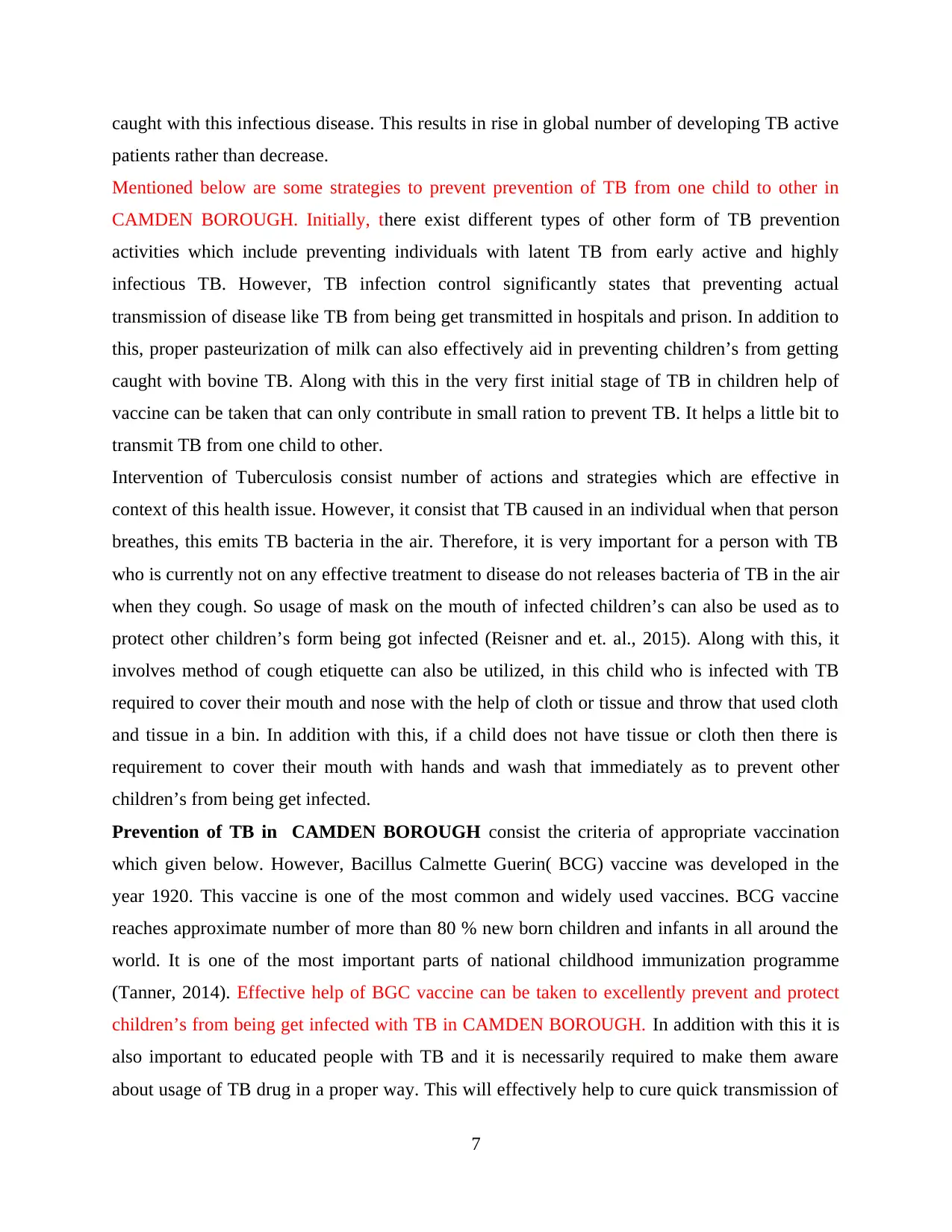
caught with this infectious disease. This results in rise in global number of developing TB active
patients rather than decrease.
Mentioned below are some strategies to prevent prevention of TB from one child to other in
CAMDEN BOROUGH. Initially, there exist different types of other form of TB prevention
activities which include preventing individuals with latent TB from early active and highly
infectious TB. However, TB infection control significantly states that preventing actual
transmission of disease like TB from being get transmitted in hospitals and prison. In addition to
this, proper pasteurization of milk can also effectively aid in preventing children’s from getting
caught with bovine TB. Along with this in the very first initial stage of TB in children help of
vaccine can be taken that can only contribute in small ration to prevent TB. It helps a little bit to
transmit TB from one child to other.
Intervention of Tuberculosis consist number of actions and strategies which are effective in
context of this health issue. However, it consist that TB caused in an individual when that person
breathes, this emits TB bacteria in the air. Therefore, it is very important for a person with TB
who is currently not on any effective treatment to disease do not releases bacteria of TB in the air
when they cough. So usage of mask on the mouth of infected children’s can also be used as to
protect other children’s form being got infected (Reisner and et. al., 2015). Along with this, it
involves method of cough etiquette can also be utilized, in this child who is infected with TB
required to cover their mouth and nose with the help of cloth or tissue and throw that used cloth
and tissue in a bin. In addition with this, if a child does not have tissue or cloth then there is
requirement to cover their mouth with hands and wash that immediately as to prevent other
children’s from being get infected.
Prevention of TB in CAMDEN BOROUGH consist the criteria of appropriate vaccination
which given below. However, Bacillus Calmette Guerin( BCG) vaccine was developed in the
year 1920. This vaccine is one of the most common and widely used vaccines. BCG vaccine
reaches approximate number of more than 80 % new born children and infants in all around the
world. It is one of the most important parts of national childhood immunization programme
(Tanner, 2014). Effective help of BGC vaccine can be taken to excellently prevent and protect
children’s from being get infected with TB in CAMDEN BOROUGH. In addition with this it is
also important to educated people with TB and it is necessarily required to make them aware
about usage of TB drug in a proper way. This will effectively help to cure quick transmission of
7
patients rather than decrease.
Mentioned below are some strategies to prevent prevention of TB from one child to other in
CAMDEN BOROUGH. Initially, there exist different types of other form of TB prevention
activities which include preventing individuals with latent TB from early active and highly
infectious TB. However, TB infection control significantly states that preventing actual
transmission of disease like TB from being get transmitted in hospitals and prison. In addition to
this, proper pasteurization of milk can also effectively aid in preventing children’s from getting
caught with bovine TB. Along with this in the very first initial stage of TB in children help of
vaccine can be taken that can only contribute in small ration to prevent TB. It helps a little bit to
transmit TB from one child to other.
Intervention of Tuberculosis consist number of actions and strategies which are effective in
context of this health issue. However, it consist that TB caused in an individual when that person
breathes, this emits TB bacteria in the air. Therefore, it is very important for a person with TB
who is currently not on any effective treatment to disease do not releases bacteria of TB in the air
when they cough. So usage of mask on the mouth of infected children’s can also be used as to
protect other children’s form being got infected (Reisner and et. al., 2015). Along with this, it
involves method of cough etiquette can also be utilized, in this child who is infected with TB
required to cover their mouth and nose with the help of cloth or tissue and throw that used cloth
and tissue in a bin. In addition with this, if a child does not have tissue or cloth then there is
requirement to cover their mouth with hands and wash that immediately as to prevent other
children’s from being get infected.
Prevention of TB in CAMDEN BOROUGH consist the criteria of appropriate vaccination
which given below. However, Bacillus Calmette Guerin( BCG) vaccine was developed in the
year 1920. This vaccine is one of the most common and widely used vaccines. BCG vaccine
reaches approximate number of more than 80 % new born children and infants in all around the
world. It is one of the most important parts of national childhood immunization programme
(Tanner, 2014). Effective help of BGC vaccine can be taken to excellently prevent and protect
children’s from being get infected with TB in CAMDEN BOROUGH. In addition with this it is
also important to educated people with TB and it is necessarily required to make them aware
about usage of TB drug in a proper way. This will effectively help to cure quick transmission of
7
⊘ This is a preview!⊘
Do you want full access?
Subscribe today to unlock all pages.

Trusted by 1+ million students worldwide
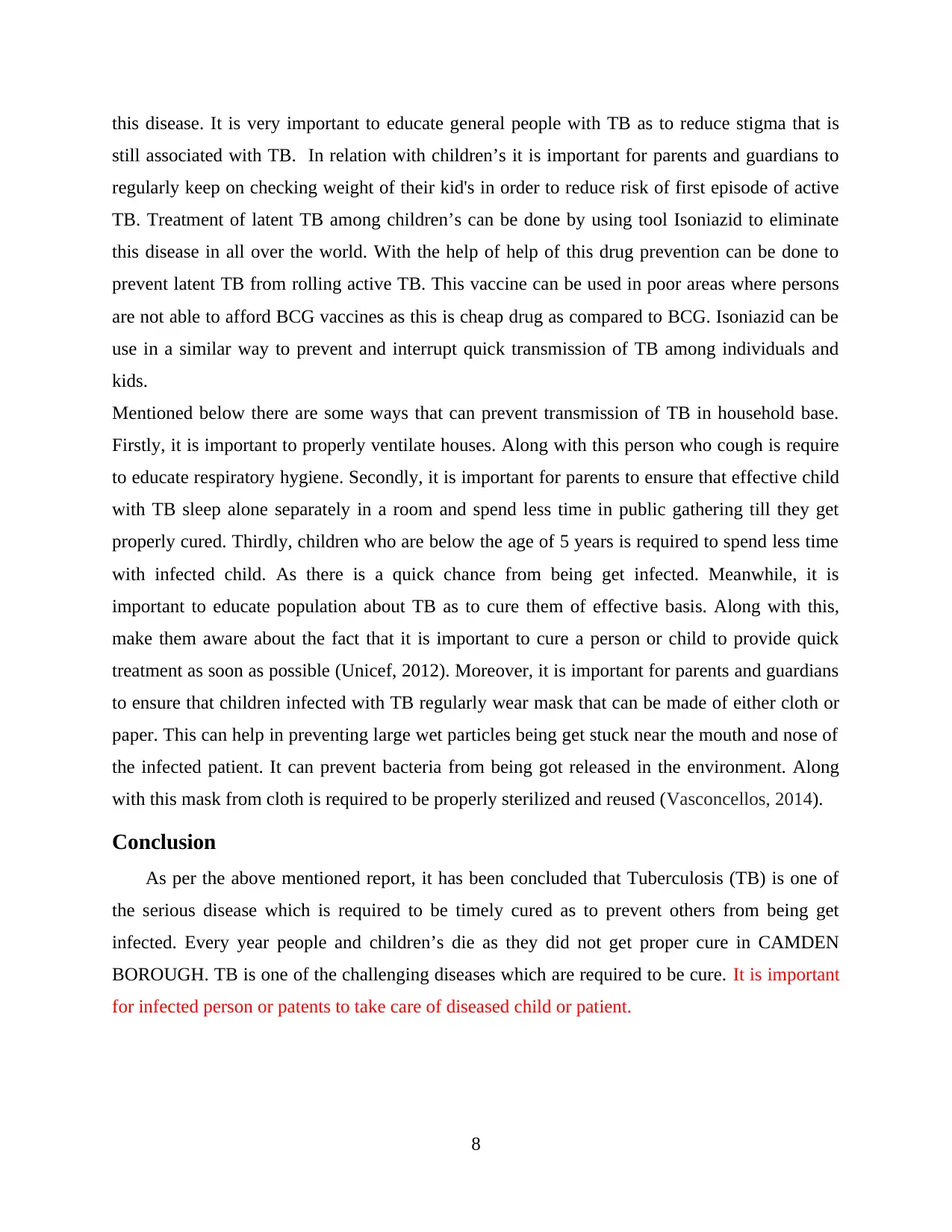
this disease. It is very important to educate general people with TB as to reduce stigma that is
still associated with TB. In relation with children’s it is important for parents and guardians to
regularly keep on checking weight of their kid's in order to reduce risk of first episode of active
TB. Treatment of latent TB among children’s can be done by using tool Isoniazid to eliminate
this disease in all over the world. With the help of help of this drug prevention can be done to
prevent latent TB from rolling active TB. This vaccine can be used in poor areas where persons
are not able to afford BCG vaccines as this is cheap drug as compared to BCG. Isoniazid can be
use in a similar way to prevent and interrupt quick transmission of TB among individuals and
kids.
Mentioned below there are some ways that can prevent transmission of TB in household base.
Firstly, it is important to properly ventilate houses. Along with this person who cough is require
to educate respiratory hygiene. Secondly, it is important for parents to ensure that effective child
with TB sleep alone separately in a room and spend less time in public gathering till they get
properly cured. Thirdly, children who are below the age of 5 years is required to spend less time
with infected child. As there is a quick chance from being get infected. Meanwhile, it is
important to educate population about TB as to cure them of effective basis. Along with this,
make them aware about the fact that it is important to cure a person or child to provide quick
treatment as soon as possible (Unicef, 2012). Moreover, it is important for parents and guardians
to ensure that children infected with TB regularly wear mask that can be made of either cloth or
paper. This can help in preventing large wet particles being get stuck near the mouth and nose of
the infected patient. It can prevent bacteria from being got released in the environment. Along
with this mask from cloth is required to be properly sterilized and reused (Vasconcellos, 2014).
Conclusion
As per the above mentioned report, it has been concluded that Tuberculosis (TB) is one of
the serious disease which is required to be timely cured as to prevent others from being get
infected. Every year people and children’s die as they did not get proper cure in CAMDEN
BOROUGH. TB is one of the challenging diseases which are required to be cure. It is important
for infected person or patents to take care of diseased child or patient.
8
still associated with TB. In relation with children’s it is important for parents and guardians to
regularly keep on checking weight of their kid's in order to reduce risk of first episode of active
TB. Treatment of latent TB among children’s can be done by using tool Isoniazid to eliminate
this disease in all over the world. With the help of help of this drug prevention can be done to
prevent latent TB from rolling active TB. This vaccine can be used in poor areas where persons
are not able to afford BCG vaccines as this is cheap drug as compared to BCG. Isoniazid can be
use in a similar way to prevent and interrupt quick transmission of TB among individuals and
kids.
Mentioned below there are some ways that can prevent transmission of TB in household base.
Firstly, it is important to properly ventilate houses. Along with this person who cough is require
to educate respiratory hygiene. Secondly, it is important for parents to ensure that effective child
with TB sleep alone separately in a room and spend less time in public gathering till they get
properly cured. Thirdly, children who are below the age of 5 years is required to spend less time
with infected child. As there is a quick chance from being get infected. Meanwhile, it is
important to educate population about TB as to cure them of effective basis. Along with this,
make them aware about the fact that it is important to cure a person or child to provide quick
treatment as soon as possible (Unicef, 2012). Moreover, it is important for parents and guardians
to ensure that children infected with TB regularly wear mask that can be made of either cloth or
paper. This can help in preventing large wet particles being get stuck near the mouth and nose of
the infected patient. It can prevent bacteria from being got released in the environment. Along
with this mask from cloth is required to be properly sterilized and reused (Vasconcellos, 2014).
Conclusion
As per the above mentioned report, it has been concluded that Tuberculosis (TB) is one of
the serious disease which is required to be timely cured as to prevent others from being get
infected. Every year people and children’s die as they did not get proper cure in CAMDEN
BOROUGH. TB is one of the challenging diseases which are required to be cure. It is important
for infected person or patents to take care of diseased child or patient.
8
Paraphrase This Document
Need a fresh take? Get an instant paraphrase of this document with our AI Paraphraser
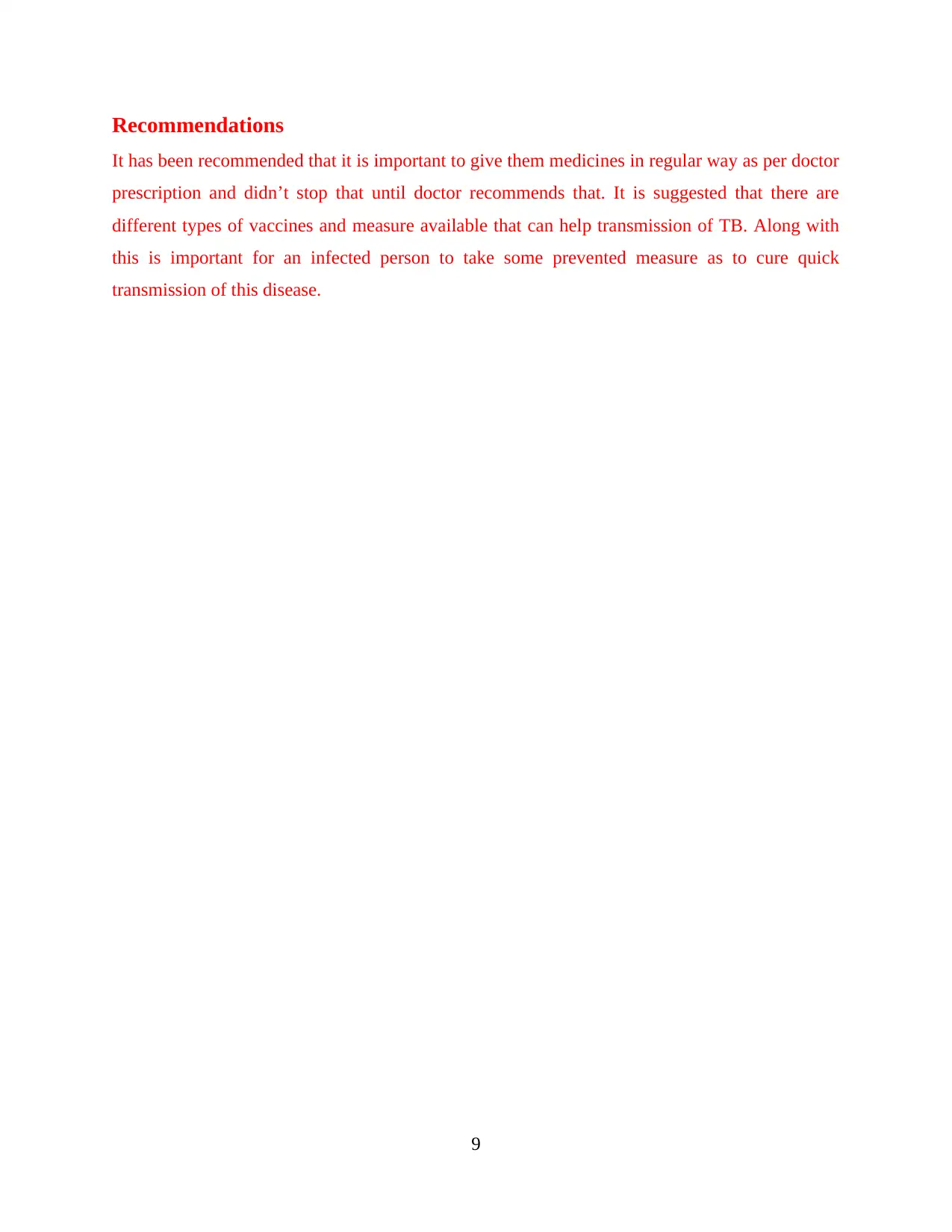
Recommendations
It has been recommended that it is important to give them medicines in regular way as per doctor
prescription and didn’t stop that until doctor recommends that. It is suggested that there are
different types of vaccines and measure available that can help transmission of TB. Along with
this is important for an infected person to take some prevented measure as to cure quick
transmission of this disease.
9
It has been recommended that it is important to give them medicines in regular way as per doctor
prescription and didn’t stop that until doctor recommends that. It is suggested that there are
different types of vaccines and measure available that can help transmission of TB. Along with
this is important for an infected person to take some prevented measure as to cure quick
transmission of this disease.
9
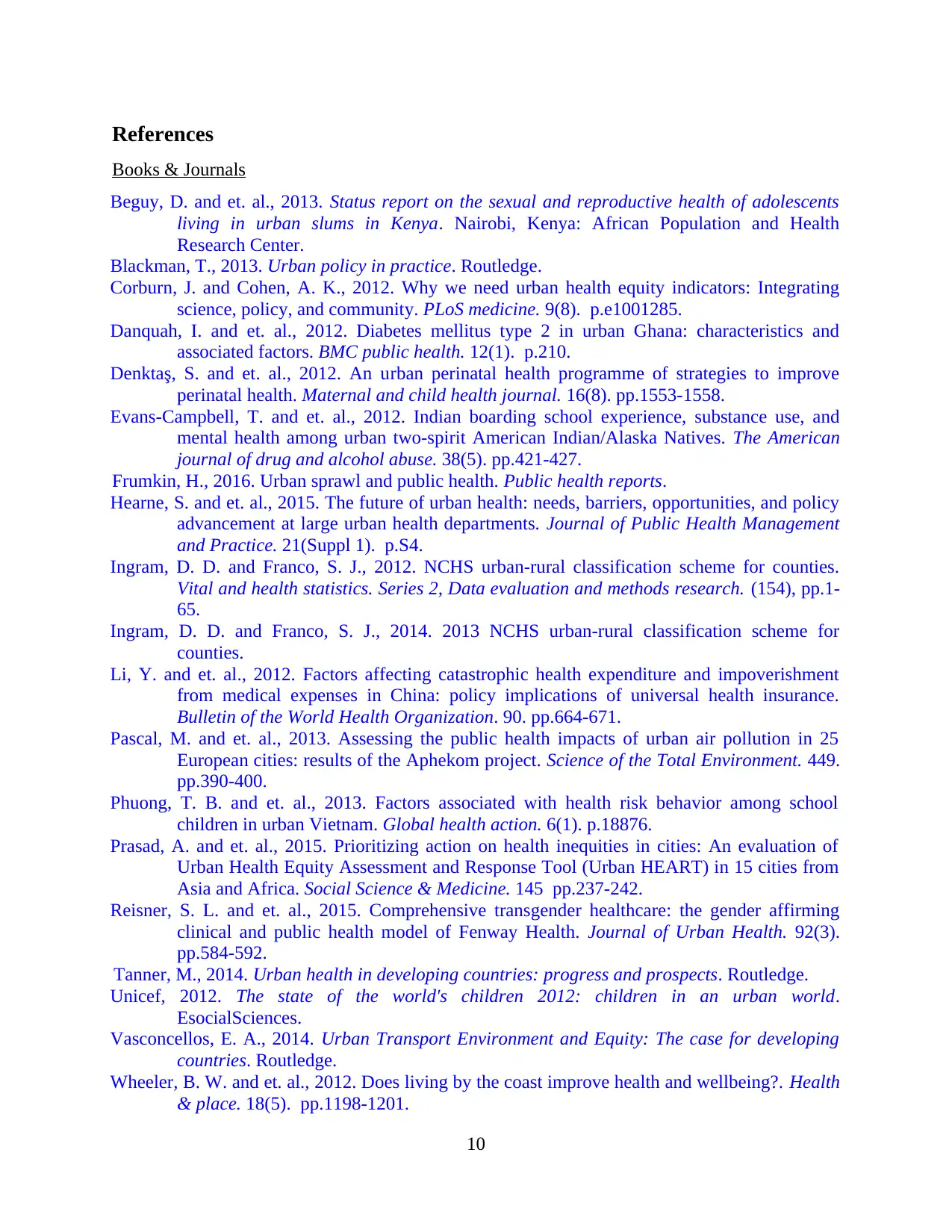
References
Books & Journals
Beguy, D. and et. al., 2013. Status report on the sexual and reproductive health of adolescents
living in urban slums in Kenya. Nairobi, Kenya: African Population and Health
Research Center.
Blackman, T., 2013. Urban policy in practice. Routledge.
Corburn, J. and Cohen, A. K., 2012. Why we need urban health equity indicators: Integrating
science, policy, and community. PLoS medicine. 9(8). p.e1001285.
Danquah, I. and et. al., 2012. Diabetes mellitus type 2 in urban Ghana: characteristics and
associated factors. BMC public health. 12(1). p.210.
Denktaş, S. and et. al., 2012. An urban perinatal health programme of strategies to improve
perinatal health. Maternal and child health journal. 16(8). pp.1553-1558.
Evans-Campbell, T. and et. al., 2012. Indian boarding school experience, substance use, and
mental health among urban two-spirit American Indian/Alaska Natives. The American
journal of drug and alcohol abuse. 38(5). pp.421-427.
Frumkin, H., 2016. Urban sprawl and public health. Public health reports.
Hearne, S. and et. al., 2015. The future of urban health: needs, barriers, opportunities, and policy
advancement at large urban health departments. Journal of Public Health Management
and Practice. 21(Suppl 1). p.S4.
Ingram, D. D. and Franco, S. J., 2012. NCHS urban-rural classification scheme for counties.
Vital and health statistics. Series 2, Data evaluation and methods research. (154), pp.1-
65.
Ingram, D. D. and Franco, S. J., 2014. 2013 NCHS urban-rural classification scheme for
counties.
Li, Y. and et. al., 2012. Factors affecting catastrophic health expenditure and impoverishment
from medical expenses in China: policy implications of universal health insurance.
Bulletin of the World Health Organization. 90. pp.664-671.
Pascal, M. and et. al., 2013. Assessing the public health impacts of urban air pollution in 25
European cities: results of the Aphekom project. Science of the Total Environment. 449.
pp.390-400.
Phuong, T. B. and et. al., 2013. Factors associated with health risk behavior among school
children in urban Vietnam. Global health action. 6(1). p.18876.
Prasad, A. and et. al., 2015. Prioritizing action on health inequities in cities: An evaluation of
Urban Health Equity Assessment and Response Tool (Urban HEART) in 15 cities from
Asia and Africa. Social Science & Medicine. 145 pp.237-242.
Reisner, S. L. and et. al., 2015. Comprehensive transgender healthcare: the gender affirming
clinical and public health model of Fenway Health. Journal of Urban Health. 92(3).
pp.584-592.
Tanner, M., 2014. Urban health in developing countries: progress and prospects. Routledge.
Unicef, 2012. The state of the world's children 2012: children in an urban world.
EsocialSciences.
Vasconcellos, E. A., 2014. Urban Transport Environment and Equity: The case for developing
countries. Routledge.
Wheeler, B. W. and et. al., 2012. Does living by the coast improve health and wellbeing?. Health
& place. 18(5). pp.1198-1201.
10
Books & Journals
Beguy, D. and et. al., 2013. Status report on the sexual and reproductive health of adolescents
living in urban slums in Kenya. Nairobi, Kenya: African Population and Health
Research Center.
Blackman, T., 2013. Urban policy in practice. Routledge.
Corburn, J. and Cohen, A. K., 2012. Why we need urban health equity indicators: Integrating
science, policy, and community. PLoS medicine. 9(8). p.e1001285.
Danquah, I. and et. al., 2012. Diabetes mellitus type 2 in urban Ghana: characteristics and
associated factors. BMC public health. 12(1). p.210.
Denktaş, S. and et. al., 2012. An urban perinatal health programme of strategies to improve
perinatal health. Maternal and child health journal. 16(8). pp.1553-1558.
Evans-Campbell, T. and et. al., 2012. Indian boarding school experience, substance use, and
mental health among urban two-spirit American Indian/Alaska Natives. The American
journal of drug and alcohol abuse. 38(5). pp.421-427.
Frumkin, H., 2016. Urban sprawl and public health. Public health reports.
Hearne, S. and et. al., 2015. The future of urban health: needs, barriers, opportunities, and policy
advancement at large urban health departments. Journal of Public Health Management
and Practice. 21(Suppl 1). p.S4.
Ingram, D. D. and Franco, S. J., 2012. NCHS urban-rural classification scheme for counties.
Vital and health statistics. Series 2, Data evaluation and methods research. (154), pp.1-
65.
Ingram, D. D. and Franco, S. J., 2014. 2013 NCHS urban-rural classification scheme for
counties.
Li, Y. and et. al., 2012. Factors affecting catastrophic health expenditure and impoverishment
from medical expenses in China: policy implications of universal health insurance.
Bulletin of the World Health Organization. 90. pp.664-671.
Pascal, M. and et. al., 2013. Assessing the public health impacts of urban air pollution in 25
European cities: results of the Aphekom project. Science of the Total Environment. 449.
pp.390-400.
Phuong, T. B. and et. al., 2013. Factors associated with health risk behavior among school
children in urban Vietnam. Global health action. 6(1). p.18876.
Prasad, A. and et. al., 2015. Prioritizing action on health inequities in cities: An evaluation of
Urban Health Equity Assessment and Response Tool (Urban HEART) in 15 cities from
Asia and Africa. Social Science & Medicine. 145 pp.237-242.
Reisner, S. L. and et. al., 2015. Comprehensive transgender healthcare: the gender affirming
clinical and public health model of Fenway Health. Journal of Urban Health. 92(3).
pp.584-592.
Tanner, M., 2014. Urban health in developing countries: progress and prospects. Routledge.
Unicef, 2012. The state of the world's children 2012: children in an urban world.
EsocialSciences.
Vasconcellos, E. A., 2014. Urban Transport Environment and Equity: The case for developing
countries. Routledge.
Wheeler, B. W. and et. al., 2012. Does living by the coast improve health and wellbeing?. Health
& place. 18(5). pp.1198-1201.
10
⊘ This is a preview!⊘
Do you want full access?
Subscribe today to unlock all pages.

Trusted by 1+ million students worldwide
1 out of 13
Related Documents
Your All-in-One AI-Powered Toolkit for Academic Success.
+13062052269
info@desklib.com
Available 24*7 on WhatsApp / Email
![[object Object]](/_next/static/media/star-bottom.7253800d.svg)
Unlock your academic potential
Copyright © 2020–2025 A2Z Services. All Rights Reserved. Developed and managed by ZUCOL.





